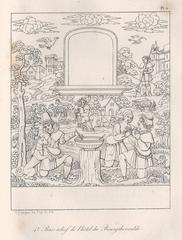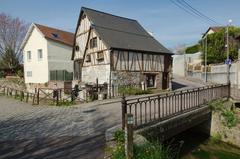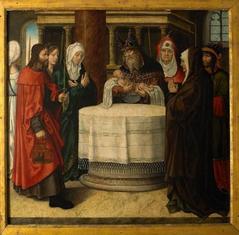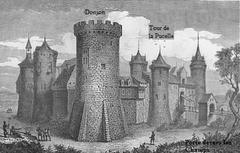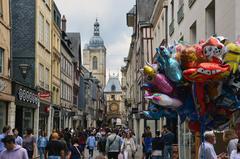Visiting the Maritime, Fluvial and Harbor Museum of Rouen, France: Tickets, Hours, and Tips
Date: 15/06/2025
Introduction: The Significance of Rouen’s Maritime, Fluvial and Harbor Museum
Situated along the Seine River in Normandy, the Maritime, Fluvial and Harbor Museum of Rouen (Musée Maritime, Fluvial et Portuaire de Rouen) is a landmark institution dedicated to preserving and interpreting the city’s storied maritime and river heritage. Housed in the atmospheric Hangar 13—a former port warehouse—the museum brings Rouen’s centuries-old role as a commercial, shipbuilding, and trading hub vividly to life. Through extensive collections, immersive displays, and authentic industrial architecture, visitors can explore how Rouen evolved from a medieval river port into a global grain exporter and a nexus of technological and cultural innovation. Whether you are a maritime enthusiast, a family, or a traveler exploring Normandy’s historical sites, the museum provides a unique and engaging experience, complemented by accessible facilities, guided tours, and interactive exhibits. For current visiting hours, ticket prices, and special programming, always consult the Official Museum Website and local tourism resources (Rouen Tourism, Normandy Tourism).
Table of Contents
- Historical Context of Rouen’s Maritime Heritage
- Creation and Mission of the Museum
- Key Collections and Notable Exhibits
- The Setting: Hangar 13 and the Living Port
- Visitor Essentials: Hours, Tickets, and Accessibility
- Community Engagement and Educational Initiatives
- Planning Your Visit: Tips and Nearby Attractions
- Frequently Asked Questions (FAQ)
- Summary and Final Recommendations
- References
Historical Context of Rouen’s Maritime Heritage
Rouen’s strategic location on the Seine, approximately 120 kilometers from the English Channel, has defined its destiny as a major port since the Middle Ages. By the 13th century, Rouen was recognized as a key trading post, facilitating the flow of goods such as wool, wine, and grain. The city’s port expanded during the colonial era, handling products from the Americas and Africa (Rouen Tourism). Its shipyards produced both merchant and naval vessels, while bustling docks reflected the industrialization of Normandy. The navigable Seine enabled not only commerce but also a flourishing maritime culture, making Rouen—by the 19th century—second only to Le Havre in port activity (Normandy Tourism).
Creation and Mission of the Museum
Inaugurated in 1999, the Maritime, Fluvial and Harbor Museum of Rouen was established by local historians, maritime enthusiasts, and former port workers with support from the city and port authorities. Its mission is to collect, conserve, and interpret artifacts, documents, and oral histories related to Rouen’s maritime and riverine past. Set in Hangar 13, the museum is both a repository of heritage and a testament to the city’s working waterfront (Official Museum Website). By highlighting the interconnectedness of sea and river transport, the museum offers a comprehensive view of Rouen’s role in global trade networks, technological innovation, and cultural exchange (Seine Maritime Tourism).
Key Collections and Notable Exhibits
Ship Models and Maritime Engineering
A centerpiece of the museum is its remarkable collection of over 200 ship models, including a 7-meter-long model of the Dauphine—the vessel that carried Jehan de Verrazane to the discovery of New York Bay in 1524 (Visiterouen). Detailed models, blueprints, and engineering tools illustrate the evolution of shipbuilding.
Port Life, Labor, and Trade
Artifacts such as dockworkers’ tools, uniforms, and oral history recordings bring to life the routines and social dynamics of those who worked on the docks. Thematic displays trace the flow of goods through Rouen’s port, from medieval times to the present, using maps, shipping manifests, and customs documents.
River Navigation and Maritime Rescue
The museum shines a spotlight on river navigation, with models of barges, lock mechanisms, and signaling equipment. A reconstructed wheelhouse from a Seine tugboat invites visitors to experience a pilot’s view. Exhibits on maritime disasters and rescue showcase artifacts recovered from wrecks and recount heroic efforts by local crews.
Pompon-Rouge Barge
Moored in the museum courtyard, the 38-meter Pompon-Rouge barge houses an exhibition on river navigation. Visitors can access the wheelhouse and hold, learning about inland waterway logistics and life aboard a working vessel (Wikipedia).
Natural History: Fin Whale Skeleton
A striking skeleton of a young fin whale (rorqual commun), washed ashore in 1927, is on display. On loan from the Rouen Natural History Museum, it highlights the region’s marine biodiversity and human impacts on river and ocean ecosystems.
Temporary and Thematic Exhibits
The museum regularly hosts temporary exhibitions on subjects such as Viking influences, the Rouen transporter bridge, and notable events like the departure of the Statue of Liberty from Rouen in 1885. These enrich the narrative with global maritime connections (Wikipedia).
The Setting: Hangar 13 and the Living Port
Hangar 13, built in the early 20th century, exemplifies Rouen’s industrial waterfront architecture. Its spacious galleries and riverside location provide an evocative backdrop for the museum’s displays. The adaptive reuse of this warehouse underscores the city’s commitment to heritage preservation (Rouen City Heritage). The museum’s location along the Quai Emile Duchemin places it near landmarks such as the Gustave Flaubert Bridge and Rouen’s modern docks—allowing visitors to contextualize exhibits in an authentic setting.
Visitor Essentials: Hours, Tickets, and Accessibility
- Opening Hours: Tuesday through Sunday, 10:00 AM–6:00 PM. Closed Mondays and select public holidays.
- Tickets: Adults €6–€7; reduced €4 for students, seniors, and groups; free for children under 12 or 18 (depending on source). Family packages and combined tickets with other Rouen sites are available (Official Museum Website).
- Guided Tours: Offered on weekends and by appointment for groups, providing in-depth insights into maritime history.
- Accessibility: The museum and Pompon-Rouge barge are wheelchair accessible. Ramps, elevators, and support for visitors with visual or hearing impairments are available upon request.
- Facilities: Cloakroom, restrooms, and museum shop. Nearby cafés and restaurants along the quay.
Travel Tip: The museum is easily reached by public transport, and public parking is nearby. Always check the museum website for the latest updates and any schedule changes.
Community Engagement and Educational Initiatives
The museum is deeply rooted in the local community. Many guides and volunteers are retired port workers, enriching visitor experiences with personal stories. The museum offers school programs, educational workshops, and participates in citywide events such as the “Fête du Port” and the Armada of Rouen—one of the world’s largest tall ship gatherings (Rouen Events Calendar). Collaborative projects and digitization of archives ensure the museum’s collections are accessible to future generations.
Planning Your Visit: Tips and Nearby Attractions
Best Times to Visit: Spring through early autumn. Weekday mornings are quieter.
Nearby Attractions:
- Rouen Cathedral
- Gros-Horloge (Great Clock)
- Joan of Arc Historial
- Rouen Museum of Fine Arts
- Le Secq des Tournelles Museum
- Flaubert and History of Medicine Museum
- Rouen Ceramic Museum
- Natural History Museum
Photography: Allowed without flash. The museum shop offers maritime souvenirs, books, and model kits.
Language: Most exhibits are in French; English translations are limited, so non-French speakers may benefit from translation apps.
Frequently Asked Questions (FAQ)
Q: What are the museum’s opening hours?
A: Tuesday to Sunday, 10:00 AM–6:00 PM; closed Mondays and select holidays.
Q: How much are tickets?
A: Adults €6–€7; students/seniors €4; children under 12 (or 18) free.
Q: Is the museum wheelchair accessible?
A: Yes, including the Pompon-Rouge barge.
Q: Are guided tours available?
A: Yes, on weekends and by appointment for groups.
Q: Where is the museum located?
A: Hangar 13, Quai Emile Duchemin, Rouen’s historic port district.
Q: Can I combine my visit with other Rouen sites?
A: Yes, combined tickets and itineraries are available via the tourism office.
Summary and Final Recommendations
The Maritime, Fluvial and Harbor Museum of Rouen stands as a vital guardian of the city’s maritime and river heritage. Its comprehensive exhibits, authentic setting, and strong community engagement provide a nuanced perspective on Rouen’s evolution as a European port city. With accessible facilities, guided tours, and proximity to other cultural attractions, the museum is an essential stop for anyone exploring Normandy’s dynamic history. For up-to-date information, always refer to the official website and consider using the Audiala travel app for a personalized experience.
References
- Visiting the Maritime Museum of Rouen: Tickets, Hours & Historical Insights, 2025, Rouen Tourism (Rouen Tourism)
- Maritime, Fluvial and Harbor Museum of Rouen Collections and Visitor Information, 2025, Official Museum Website (Official Museum Website)
- Maritime, Fluvial and Harbor Museum of Rouen Overview and Exhibits, 2025, Wikipedia (Wikipedia)
- Normandy Tourism: Maritime Heritage and Rouen Port History, 2025, Normandy Tourism (Normandy Tourism)
- Exploring Rouen Historical Sites, 2025, Visiterouen (Visiterouen)
- Seine Maritime Tourism: Museum Significance and Visitor Guidance, 2025, Seine Maritime Tourism (Seine Maritime Tourism)
- Rouen City Heritage and Cultural Setting, 2025, Rouen Tourism (Rouen City Heritage)
- Rouen Events Calendar: Community Engagement and Festivals, 2025, Rouen Tourism (Rouen Events Calendar)
- Maritime, Fluvial and Harbor Museum of Rouen Visitor Details, 2025, FranceRent (FranceRent)
